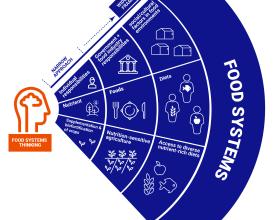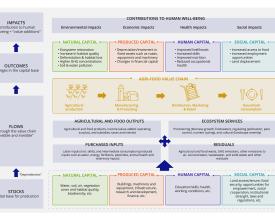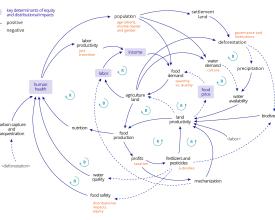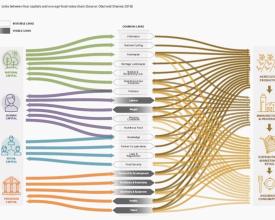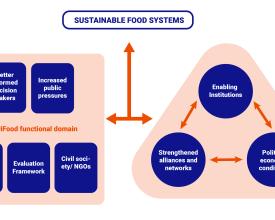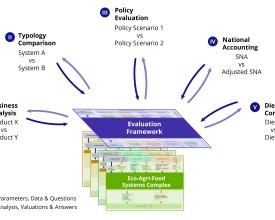
Initiative TEEBAgriFood de l'ONU Environnement - L'économie des écosystèmes et de la biodiversité pour l'agriculture et l'alimentation
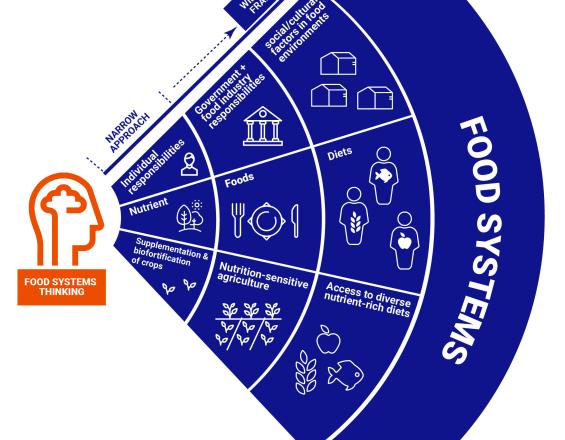
L'initiative TEEBAgriFood a mis au point un cadre d'évaluation unique et complet qui permet d'évaluer les impacts et les externalités des systèmes agricoles et alimentaires - les externalités environnementales, sanitaires, sociales et culturelles, tant positives que négatives, et ce, tout au long des chaînes de valeur. Ce cadre permet d'élaborer et d'illustrer les arguments en faveur d'une pensée "systémique" plutôt que d'une pensée "en silo". Cette approche holistique de la "comptabilité analytique" permet aux décideurs de mieux comparer les différentes politiques et le marché afin d'évaluer l'agriculture et l'alimentation de manière plus précise. Ainsi, TEEBAgriFood aidera à surmonter les obstacles et à développer efficacement l'agroécologie pour aboutir à des systèmes agricoles et alimentaires plus équitables. Pour son approche globale offrant des opportunités de contribuer à la majorité des ODD et proposant un système efficace de " comptabilité analytique réelle ", TEEBAgriFood a été récompensé par le Future Policy Vision Award 2018, décerné par le World Future Council en partenariat avec la FAO et IFOAM - Organics International.
Contexte
Défis à relever
Si nous ne transformons pas la façon dont nous produisons de l'énergie et la façon dont nous produisons et consommons des aliments, les programmes internationaux tels que l'Accord de Paris ou l'Agenda 2030 ne pourront pas être réalisés. Nous devons modifier considérablement la manière dont nous produisons, transformons, distribuons et consommons les denrées alimentaires afin d'atteindre les objectifs de développement durable (ODD). Cependant, la plupart du temps, de nombreuses externalités positives et négatives ne sont pas prises en compte, ce qui rend cette transformation fondamentale impossible. Par exemple, la productivité agricole est généralement mesurée par le rendement à l'hectare, une mesure simpliste qui ne donne qu'une image incomplète des coûts et bénéfices réels associés à l'agriculture et aux chaînes de valeur alimentaires. Il est donc nécessaire de mettre en place un système holistique et efficace de "comptabilité des coûts réels", comme le propose le cadre TEEBAgriFood.
Emplacement
Traiter
Résumé du processus
Avec les bons objectifs (BB1) et les bonnes hypothèses, le développement de TEEBAgriFood (BB2) a pu commencer et développer le cadre d'évaluation et les méthodologies de TEEBAgriFood (BB3). Le résultat - le cadre d'évaluation de TEEBAgriFood - peut maintenant déployer son potentiel en tant que modèle transférable (BB4).
Blocs de construction
Objectifs
TEEBAgriFood est une approche systémique qui rassemble les différentes disciplines et perspectives liées à l'agriculture et à l'alimentation, un cadre d'évaluation qui soutient l'évaluation complète, universelle et inclusive des systèmes éco-agroalimentaires, un ensemble de méthodologies et d'outils pour la mesure des externalités positives et négatives, et une théorie du changement pour aider à intégrer TEEBAgriFood dans le vaste paysage de plateformes et d'initiatives, comme les ODD, qui s'attaquent à ces questions complexes. Il joue donc un rôle crucial dans la transformation des systèmes agricoles et alimentaires.
Facteurs favorables
La TEEB repose sur trois principes fondamentaux :
- Reconnaître que les externalités du comportement humain sur les écosystèmes, les paysages, les espèces et d'autres aspects de la biodiversité sont une caractéristique de toutes les sociétés et communautés humaines.
- L'évaluation de ces externalités en termes économiques est souvent utile aux décideurs politiques et aux parties prenantes des entreprises pour prendre des décisions.
- La gestion des externalités implique l'introduction de mécanismes qui intègrent les valeurs des écosystèmes dans la prise de décision par le biais d'incitations et de signaux de prix.
Leçon apprise
Les bénéficiaires de TEEBAgriFood sont très divers, allant des consommateurs aux petits exploitants agricoles. Les parties prenantes sont les décideurs politiques, les chercheurs, les agriculteurs, les consommateurs, les entreprises, les investisseurs, les bailleurs de fonds et les communautés de donateurs.
Développement de TEEBAgriFood
La TEEB, connue pour ses recherches pionnières sur les valeurs économiques de la nature en 2010, a réuni plus de 150 experts de 33 pays pour délivrer un message fort et urgent à la communauté mondiale sur la nécessité d'une transformation de nos systèmes agricoles et alimentaires qui soit durable, équitable et saine. L'initiative TEEBAgriFood rassemble des scientifiques, des économistes, des décideurs politiques, des chefs d'entreprise et des organisations d'agriculteurs pour convenir de la manière d'encadrer, d'entreprendre et d'utiliser des évaluations holistiques des systèmes agricoles, des pratiques, des produits et des scénarios politiques en fonction d'une gamme complète d'impacts et de dépendances tout au long des chaînes de valeur alimentaires.
Facteurs favorables
TEEBAgriFood est hébergé par le Bureau de l'économie des écosystèmes et de la biodiversité (TEEB) du Programme des Nations unies pour l'environnement (ONU Environnement). L'Alliance mondiale pour l'avenir de l'alimentation, la Commission européenne et l'Agence norvégienne de coopération au développement soutiennent l'initiative.
Leçon apprise
Fruit d'une collaboration interdisciplinaire, le TEEBAgriFood va plus loin que le TEEB original en ce sens qu'il cherche à inclure des externalités qui ne sont généralement pas prises en compte dans l'économie de l'environnement. Il s'agit notamment des externalités sociales, culturelles et sanitaires des systèmes alimentaires, qu'elles soient négatives ou positives (les stocks des systèmes éco-agro-alimentaires comprennent quatre "capitaux" différents - le capital produit, le capital naturel, le capital humain et le capital social - qui sous-tendent une variété de flux englobant l'activité de production et de consommation, les services écosystémiques, les intrants achetés et les flux résiduels).
Cadre et méthodes d'évaluation de TEEBAgriFood
Le cadre d'évaluation de TEEBAgriFood répond à la question : Que devrions-nous évaluer à propos des systèmes alimentaires ? Et les méthodologies de TEEBAgriFood répondent à la question : Comment réaliser ces évaluations ? TEEBAgriFood illustre cinq familles d'applications pour comparer : (a) différents scénarios politiques ; (b) différentes typologies agricoles ; (c) différents produits alimentaires et boissons ; (d) différents régimes/plateaux alimentaires ; et (e) des comptes nationaux ou sectoriels ajustés par rapport aux comptes conventionnels.
Facteurs favorables
TEEBAgriFood donne dix exemples montrant comment appliquer ce cadre et ces méthodologies à différents types d'évaluations. L'un d'entre eux est, par exemple, une étude menée en Nouvelle-Zélande sur 15 champs conventionnels et 14 champs biologiques, qui a évalué 12 services écosystémiques et a constaté que les cultures ainsi que d'autres services écosystémiques étaient plus élevés dans les champs biologiques.
Leçon apprise
Le cadre d'évaluation de TEEBAgriFood fournit une structure et une vue d'ensemble de ce qui devrait être inclus dans l'analyse. Toutefois, les méthodes d'évaluation dépendent des valeurs à évaluer, de la disponibilité des données et de l'objectif de l'analyse. Idéalement, il faudrait pouvoir dire avec une certaine assurance quelles sont les externalités associées à chaque euro ou dollar dépensé pour un type de nourriture donné, produit, distribué et éliminé d'une manière donnée. L'application du cadre nécessite une approche interdisciplinaire, dans laquelle toutes les parties prenantes concernées, y compris les décideurs politiques, les entreprises et les citoyens, comprennent et identifient les questions auxquelles l'exercice d'évaluation doit répondre. Par conséquent, l'engagement des parties prenantes dans tous les secteurs est essentiel à l'application efficace de TEEBAgriFood dans des contextes et des arènes politiques spécifiques.
Le potentiel d'un modèle transférable
Des fonds ont été obtenus pour appliquer le cadre d'évaluation TEEBAgriFood dans divers contextes au niveau national au Brésil, en Chine, en Colombie, en Éthiopie, au Ghana, en Inde, en Indonésie, au Kenya, en Malaisie, au Mexique, au Sénégal, en Tanzanie et en Thaïlande. À travers le Sénégal, la Tanzanie, l'Éthiopie et le Ghana, l'application présentera un récit régional avec des exemples d'études de cas nationales sur les systèmes agricoles, les pratiques, les produits et les scénarios politiques, dans le but global de contribuer à l'Agenda 2030 pour le développement durable et à un large éventail d'ODD. Au Brésil, en Chine, en Inde, en Indonésie, en Malaisie, au Mexique et en Thaïlande, l'application de l'initiative TEEBAgriFood vise à protéger la biodiversité et à contribuer à un secteur agricole et alimentaire plus durable en vue d'évoluer vers des conditions de concurrence équitables en évitant la concurrence déloyale due à des normes environnementales peu exigeantes.
Facteurs favorables
- Avec le soutien des donateurs et grâce à l'adhésion des gouvernements, du secteur privé, etc., l'initiative TEEBAgriFood déploiera tout son impact.
Leçon apprise
Le plan de travail s'appuiera sur un cadre méthodologique internationalement reconnu, introduit dans le contexte du G8+5 par l'UE, qui traite de l'économie des écosystèmes et de la biodiversité. Il réunira des gouvernements, des entreprises et d'autres acteurs clés de la société civile pour mettre en œuvre des activités visant à influencer les décisions et les comportements dans les pays participants. Ce sera la première fois que le cadre méthodologique développé par la TEEB sera appliqué à un secteur industriel (le secteur agro-industriel) sur l'ensemble de la chaîne de valeur de ce secteur, en évaluant des scénarios en vue de promouvoir le changement.
Impacts
Même si l'impact concret de TEEBAgriFood est à ce jour limité, il est novateur car c'est la première fois que l'ensemble des avantages et des coûts associés à toutes les dimensions pertinentes de la chaîne de valeur éco-agroalimentaire sont présentés dans un seul et même rapport. Comme il est clair que ce n'est qu'après avoir reconnu et démontré la valeur de ce qui est perdu que nos réponses - qu'elles soient politiques, commerciales ou citoyennes - s'adapteront, l'influence de TEEBAgriFood sur la recherche et la prise de décision futures ne peut pas être sous-estimée.
La TEEB a été reconnue au niveau mondial pour la première fois en 2008, lorsque des représentants de 13 des plus grandes économies du monde (le G8+5) ont commandé la toute première analyse mondiale des avantages économiques de la diversité biologique et des coûts de sa perte. TEEBAgriFood est l'une des deux applications les plus ambitieuses de la TEEB. Le rapport intermédiaire présentant le cadre d'évaluation de TEEBAgriFood a été lancé en 2015 lors de la COP 21 de la CCNUCC, et les études exploratoires ont été publiées individuellement entre l'automne 2016 et le printemps 2017. L'Alliance mondiale pour l'avenir de l'alimentation a présenté les fondements du cadre lors d'événements internationaux majeurs.
Le 4 juin 2018, le rapport sur les fondements scientifiques et économiques a été publié, salué par un certain nombre de personnalités éminentes, notamment Erik Solheim, Pavan Sukhdev, Alexander Müller, ainsi que par des parties prenantes d'organisations internationales.
Bénéficiaires
Afin d'améliorer et de sécuriser nos systèmes éco-agroalimentaires et, en particulier, d'atténuer leurs effets négatifs, toutes les parties prenantes, y compris les gouvernements, les entreprises, les agriculteurs et les citoyens, doivent en être conscientes.
Objectifs de développement durable
Histoire

Haripriya Gundimeda, de l'Institut indien de technologie de Bombay, déclare : En tant que professeur d'économie de l'environnement en Inde, j'ai été étroitement impliqué dans l'"Économie des écosystèmes et de la biodiversité" (EEB) au cours des dernières années. L'EEB pour l'agriculture et l'alimentation m'a particulièrement ouvert les yeux en tant que chercheur, car elle met en lumière les liens complexes, profondément imbriqués et souvent invisibles entre l'agriculture et les systèmes alimentaires et le bien-être humain.
À la suite des rapports TEEBAgriFood, j'ai décidé d'appliquer l'approche systémique et le cadre global à un exemple qui m'est proche : la chaîne de valeur du riz et du blé au Pendjab. Dans cette région, il y a peu de temps entre la récolte du riz et la préparation des champs pour la culture du blé. Si l'on ajoute à cela l'absence de technologies alternatives de récolte économiquement viables, on obtient des externalités importantes sous la forme d'une pollution de l'air due à la combustion des tiges de riz, qui nuit à la santé non seulement des citoyens locaux, mais aussi de ceux des États indiens environnants. Dans le même temps, les politiques qui imposent de mélanger les biocarburants au pétrole créent des dommages encore plus importants qui ne sont pas comptabilisés.
En effet, en matière de comptabilité nationale, nos indicateurs ne tiennent pas compte de la dépréciation des sols et indiquent à tort une augmentation de la croissance économique, car les engrais et les pesticides sont de plus en plus utilisés et le secteur chimique connaît une augmentation de la valeur ajoutée. Il est donc important de relier tous ces points et de combler les lacunes de la pensée économique actuelle. J'ai l'intention d'utiliser le cadre TEEBAgriFood pour refléter une approche systémique plus large de ces politiques et pratiques agricoles, afin d'illustrer leurs impacts involontaires et leurs coûts cachés.

